Ride Connecticut & Wisconsin Ave NW! – eWheel Going Out Group
< Click here to go back to RSVP page
*** It’s a great day for an ewheel ride. See you there! ***
UPDATE #4: The email with my cell no. has been sent to the yes RSVPs. TEXT me if you need to. If you do not see my email, check your spam folder, and also make sure your email and Meetup settings allow for you to always receive messages from the organizer. If it’s not there, send me a message through my Meetup profile with your cell no. Just a reminder, we’ll meet at the fountain within Dupont Circle itself. See you there!
UPDATE #3: Weather.com is currently forecasting temperatures in the upper 80s with an 85% chance of no rain (or from a glass half empty perspective, a 15% chance of rain) for our location’s zip code. Per the “Rain” section of the full event description, this event is a “go.” Please dress appropriately for the weather. See you there!
UPDATE #2: Weather reports are showing a 75% chance of rain during our ride. Per the “Rain” section of the event posting and for everyone’s safety, I’m rescheduling to Sat. May 12th (the only day in the next month and a half that I have available), same time, same place. This UPDATE has been emailed to the yes RSVPs. I look forward to seeing you there!
UPDATE #1: I did a dry run of the route this past weekend and due to the challenging brick sidewalks of Georgetown, decided to modify the final 1/4 of the route to take us down Massachusetts Ave instead. I’ve updated the event posting accordingly. I look forward to seeing you there!
—
Let’s get together for our first ride of the year now that the weather is warming up!
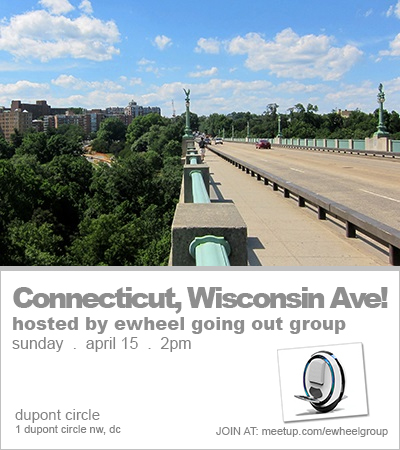
Riders from previous Meetups (Dave, Edwin, Haitao, Heather, James, Kris, Loren, Mark, Richard, Robert, and Shelly), come join us again! New riders, come join us for the first time!
We’ll ride Connecticut and Wisconsin Ave NW and stop numerous times along the way to enjoy the sites, memorials, landmarks, and to also let some of the slower riders catch up (if some of us decide to go at a quicker speed). Ideally, we will all ride together and at the same speed, but that may or may not be possible with other pedestrians, bicyclists, etc. sharing the same paths, but let’s do our best please! In total, it’s an ~8 mile trip that’s sure to be enjoyable!
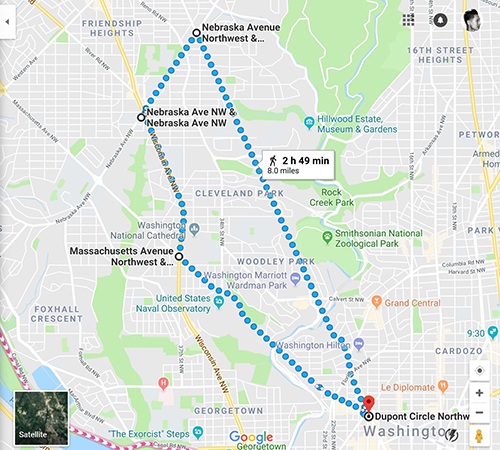
(Connecticut & Wisconsin Ave NW Ride Overview)
We’ll meet up at Dupont Circle at 2pm. Then we’ll ride northwest along Connecticut Ave NW for ~3.5 miles through the Woodley Park, Cleveland Park, and Van Ness neighborhoods to Nebraska Ave NW, at 2:30pm.
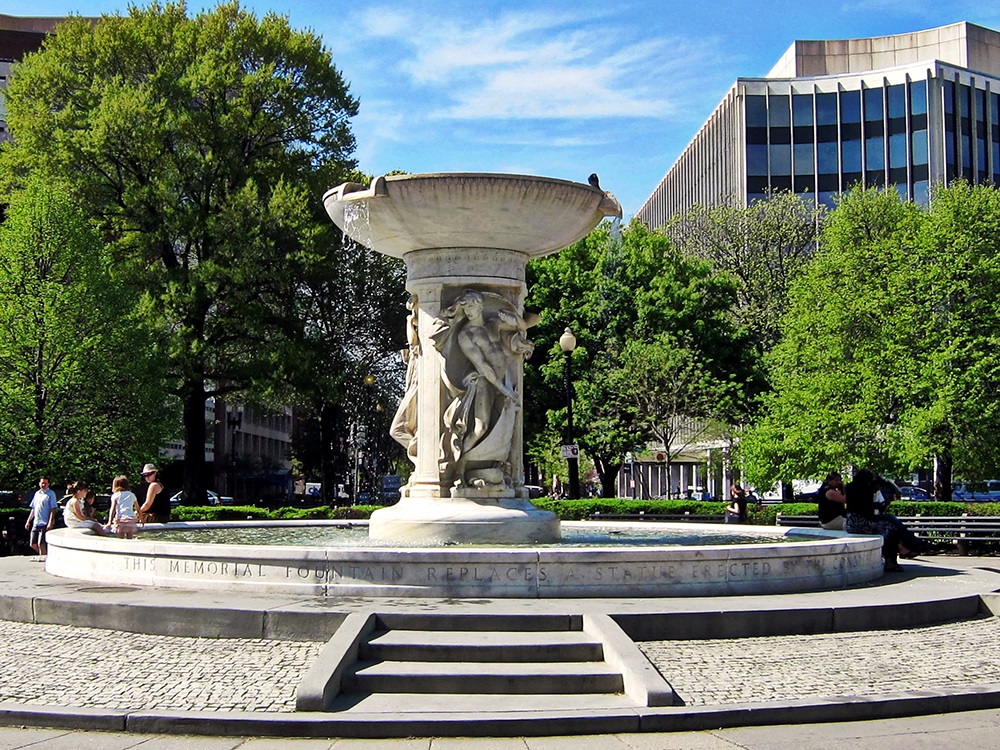
(Dupont Circle)
Dupont Circle is a traffic circle, park, neighborhood, and historic district. The Dupont Circle fountain, located at the center of Dupont Circle, was designed by Henry Bacon and sculpted by Daniel Chester French. The marble fountain is in honor of Rear Admiral Samuel Francis Du Pont. The fountain’s shaft features carvings of three classical nudes symbolizing the sea, the stars, and the wind. Sculpted in 1921, the fountain is designated a contributing property to the Dupont Circle Historic District, listed on the National Register of Historic Places in 1978.
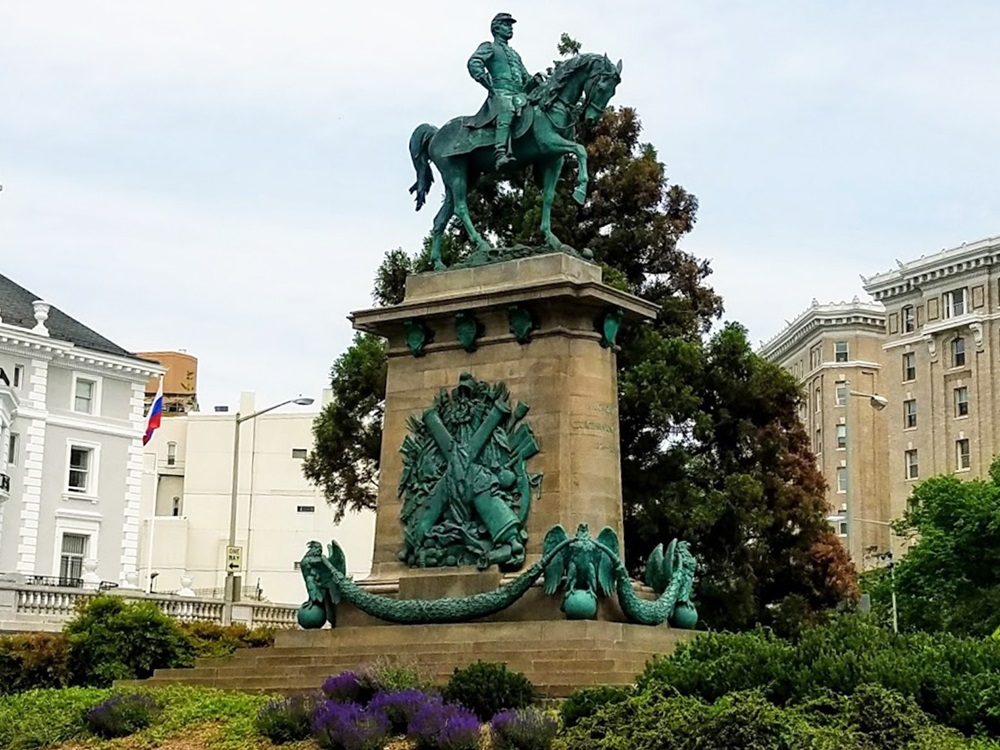
(Major General George B. McClellan statue)
Along the way, we’ll come across George McClellan Park (intersection of California Street NW), an extremely small park located on a small triangle. A sculpture of Major General George B. McClellan honors the politician and Civil War general. The monument is sited on a prominent location in the Kalorama Triangle neighborhood due to efforts made by area residents. The monument was dedicated in 1907, with prominent attendees at the ceremony including President Theodore Roosevelt, New York City mayor George B. McClellan, Jr., politicians, generals and thousands of military personnel. The sculpture is one of eighteen Civil War monuments in DC, which were collectively listed on the National Register of Historic Places in 1978. The monument and park are owned and maintained by the National Park Service, a federal agency of the Interior Department.
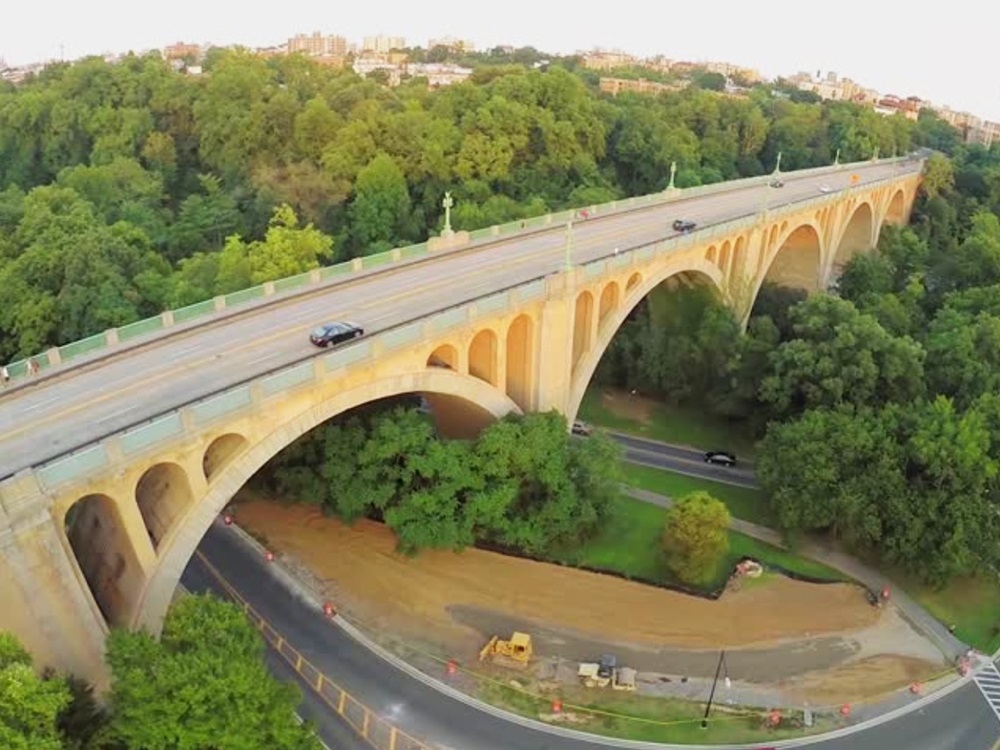
(Taft Bridge)
We’ll cross the Taft Bridge, a historic bridge that carries Connecticut Avenue over the Rock Creek gorge, including Rock Creek and the Rock Creek and Potomac Parkway. The Classical Revival bridge was built between 1897–1907. It is an arch bridge with unreinforced concrete arches and a reinforced concrete deck. The total length of the bridge is 901 ft. It has been called an “engineering tour de force” and the largest unreinforced concrete structure in the world. In 1931, the bridge was renamed in honor of U.S. President William Howard Taft, who frequently walked the bridge while Chief Justice of the Supreme Court. During early planning for the Washington Metro in the 1960s, the Red Line was slated to run across the bridge to connect Dupont Circle and Woodley Park. Instead, the metro was built underground.

(Woodley Park neighborhood)
Once we cross over the bridge, we’ll be in the affluent Woodley Park neighborhood. It is the gateway to the Smithsonian’s National Zoo, known for its giant pandas. The zoo sits in sprawling Rock Creek Park, which offers miles of hiking and biking trails. On main strip Connecticut Avenue, eateries serve everything from curry to Cajun food. Nearby, the landmark Omni Shoreham Hotel has hosted many presidential inaugural balls, and was a stop for The Beatles during their 1964 tour.
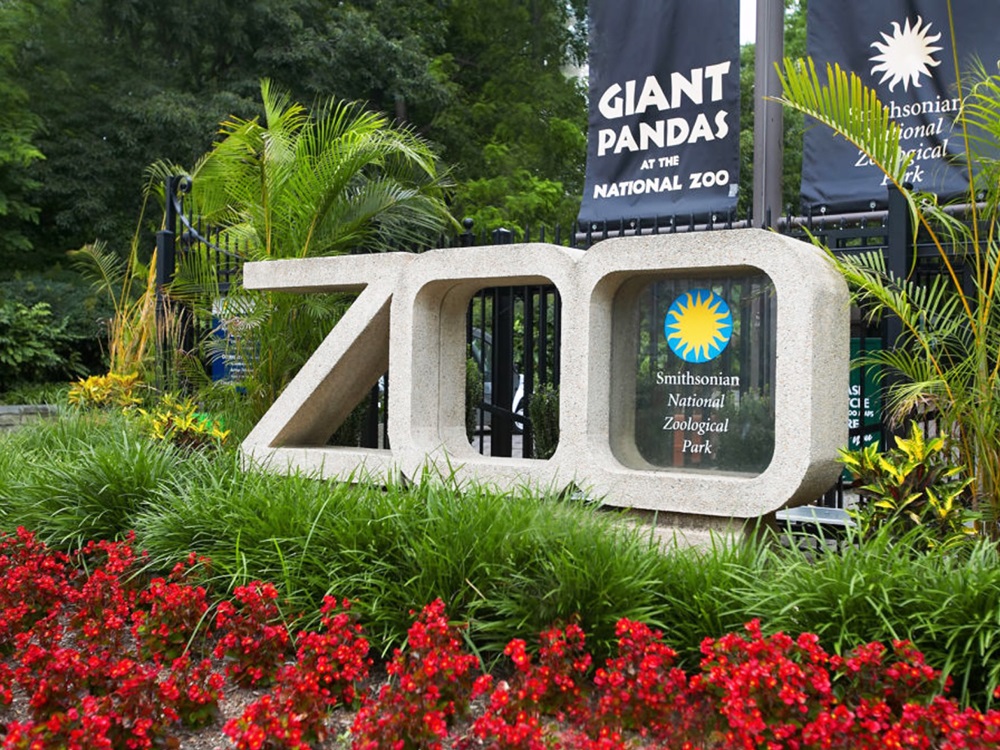
(National Zoo)
We’ll pass by the National Zoo, one of the oldest zoos in the United States. It is part of the Smithsonian Institution and does not charge for admission. Founded in 1889, its mission is to “provide engaging experiences with animals and create and share knowledge to save wildlife and habitats”. The National Zoo hosts about 1,800 animals of 300 different species. About one-fifth of them are endangered or threatened. The best-known residents are the giant pandas, but the zoo is also home to birds, great apes, big cats, Asian elephants, insects, amphibians, reptiles, aquatic animals, small mammals and many more.
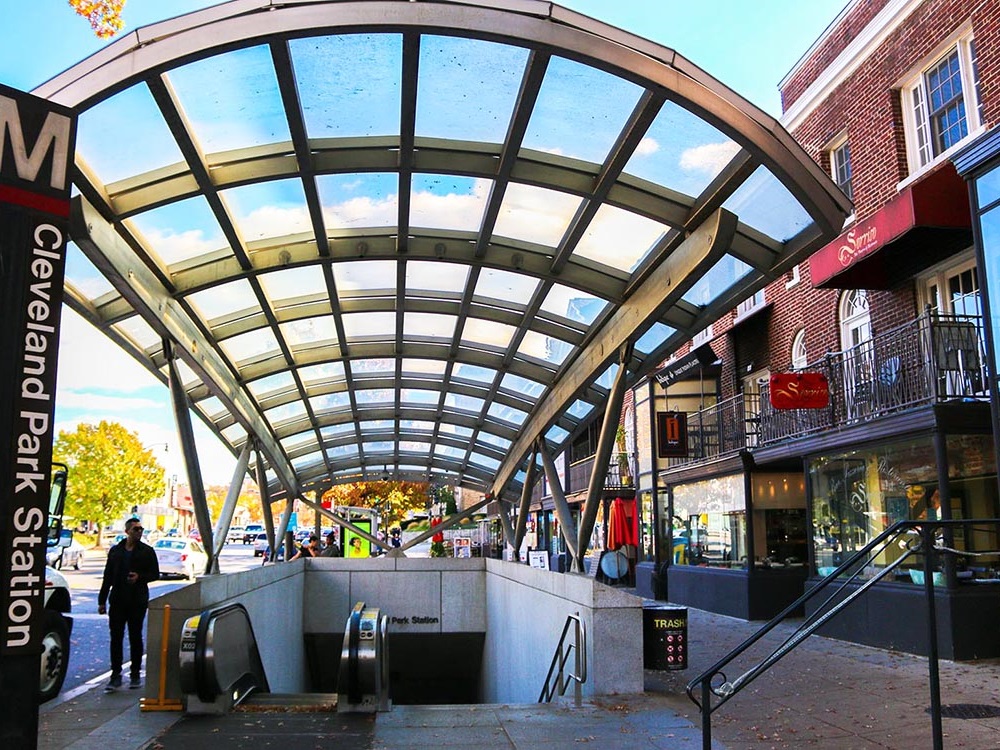
(Cleveland Park neighborhood)
Along the way, we’ll enter the Cleveland Park neighborhood (intersection of Macomb Street NW). Cleveland Park is a residential neighborhood. Its main commercial corridor lies along Connecticut Avenue, NW, where the eponymous Cleveland Park station of the Washington Metro’s Red Line can be found; another commercial corridor lies along Wisconsin Avenue. The neighborhood is known for its many late 19th century homes and the historic Art Deco Uptown Theater. It is also home to the William L. Slayton House and the Park and Shop, built in 1930 and one of the earliest strip malls.
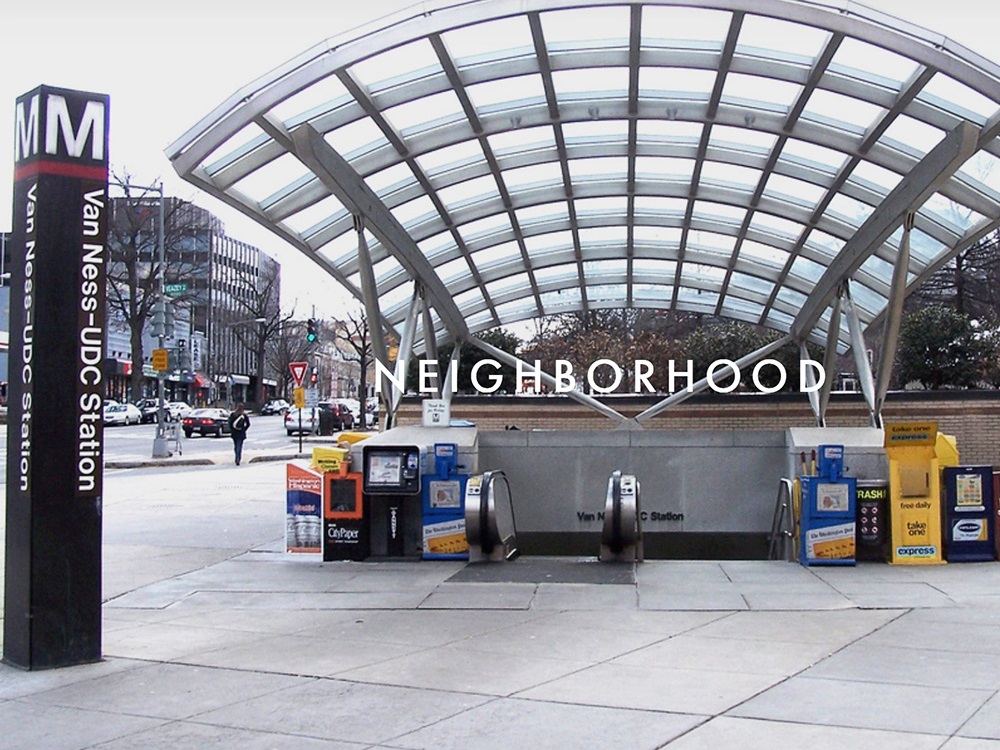
(Van Ness neighborhood)
Next we’ll enter the Van Ness neighborhood (intersection of Van Ness Street NW). Once the site of the Civil War-era Fort Kearny (of which no trace remains today), Van Ness has changed itself to embrace art, culture, cuisines and fashion. Places from Acacia Bistro for Mediterranean cuisine to the ideal urban escape at Rock Creek Park are well liked by most of the locals in the area during the weekends. The Hillwood Museum and Gardens of DC helps residents to catch their breath and enjoy the collaboration between art and nature. Before 2013, not much was thought of this Van Ness. But since it’s major renovations, renters have been flocking. Join the new crowd and move to Van Ness before the word gets out about this cool, freshly styled neighborhood.
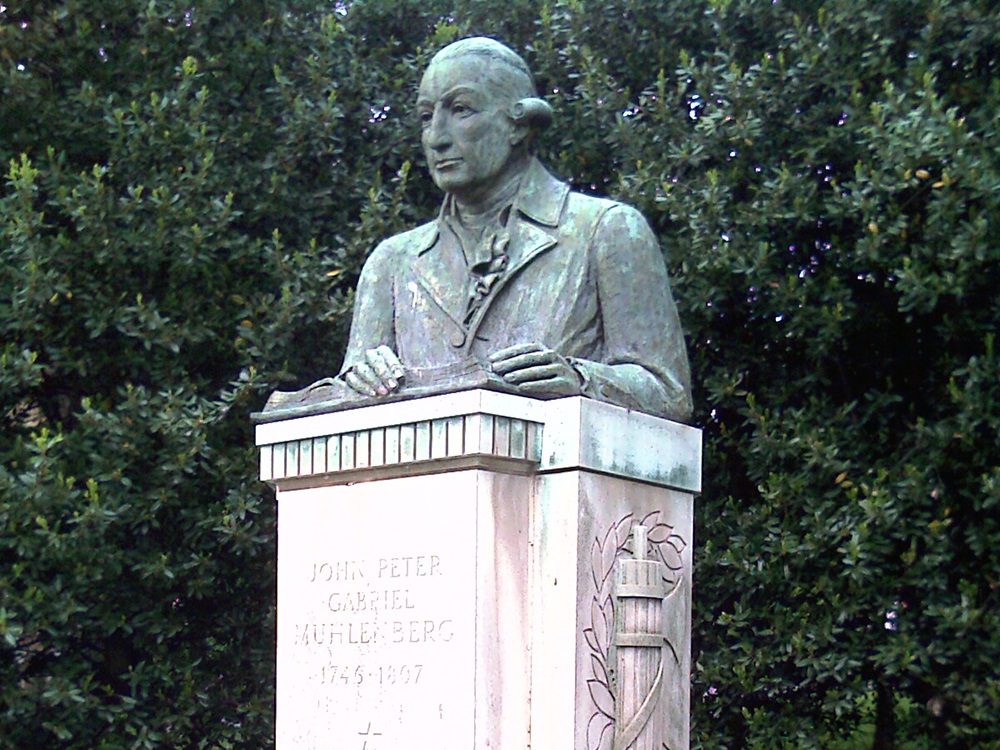
(Peter Muhlenberg Memorial)
We’ll come across the Peter Muhlenberg Memorial (intersection of Ellicott Street NW). John Peter Gabriel Muhlenberg fought in many major battles of the American Revolution and retired from the Army as a General. He had been a pastor when the war began, serving both Lutheran and Episcopal congregations. When he decided to become a soldier, he told his parishioners: “in the language of Holy Writ the is a time for all things… there is a time to pray and a time to fight… and that time has now come.” Three hundred men from his congregations joined the Army. The memorial was constructed with private funds for $59,430, and dedicated on October 26, 1980.
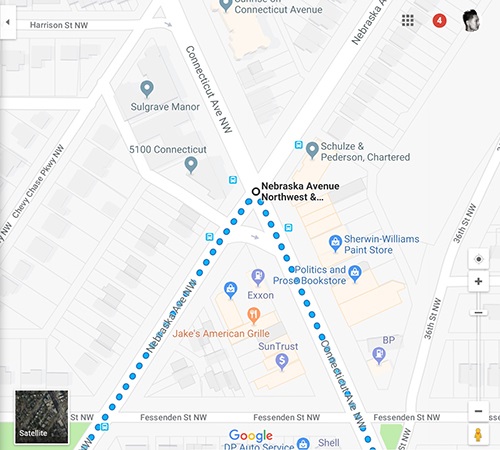
(Turn left onto Nebraska Ave NW)
When we arrive at Nebraska Ave NW, we’ll turn left onto it, going southwest towards Wisconsin Ave NW for ~1 mile.
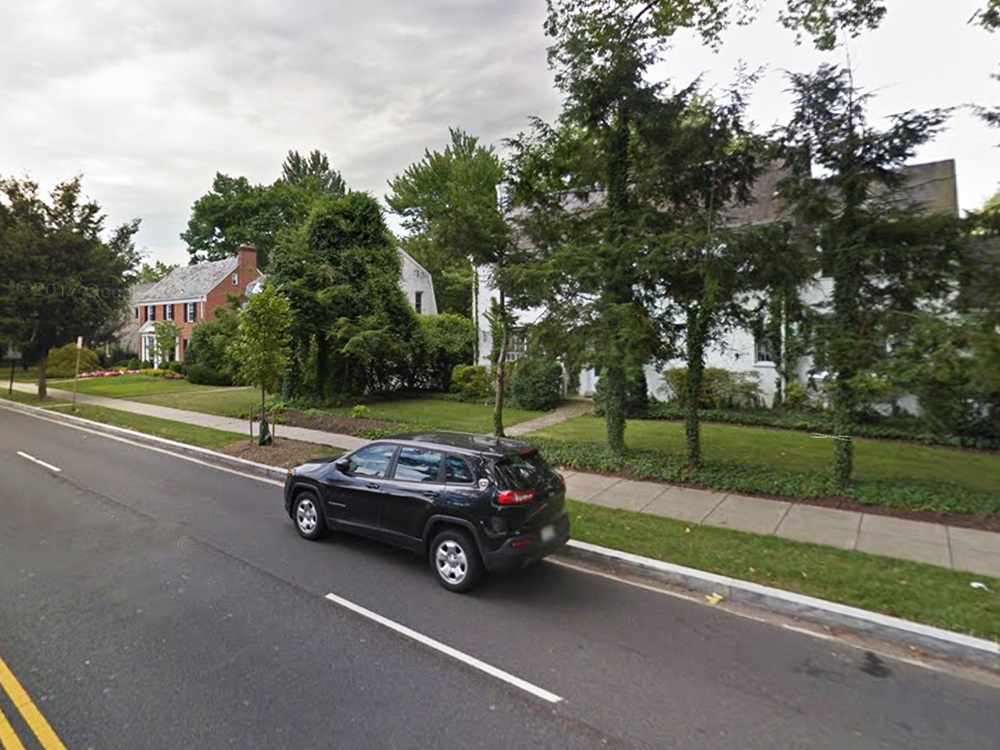
(Wakefield neighborhood)
Shortly after, we’ll enter the residential Wakefield neighborhood. The area was first developed in the 1930s by R.B. Warren, who built 100 brick homes between Nebraska and Connecticut north of Albemarle and named the new neighborhood “Wakefield,” after the plantation where George Washington was born. This new residential development was part of, and contributed to, the burgeoning growth along Connecticut Avenue. The neighborhood also includes a public school, Ben W. Murch Elementary School, and a fire house, DC Engine Company #31, both built and placed into service in 1930. In May, 2014, the Washington Post reported that Wakefield had become one of the most popular neighborhoods in Washington, D.C. according to the real-estate listing service MRIS. Homes in Wakefield appreciated more than any other neighborhood in the District in the 12 months to July 2015, up 42 percent from $573,433 to $814,045.
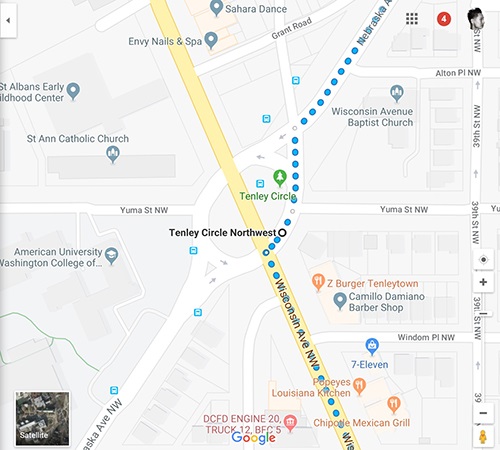
(Turn left onto Wisconsin Ave NW)
When we arrive at Tenley Circle, we’ll turn left onto Wisconsin Ave NW and head southeast for ~1.5 miles.
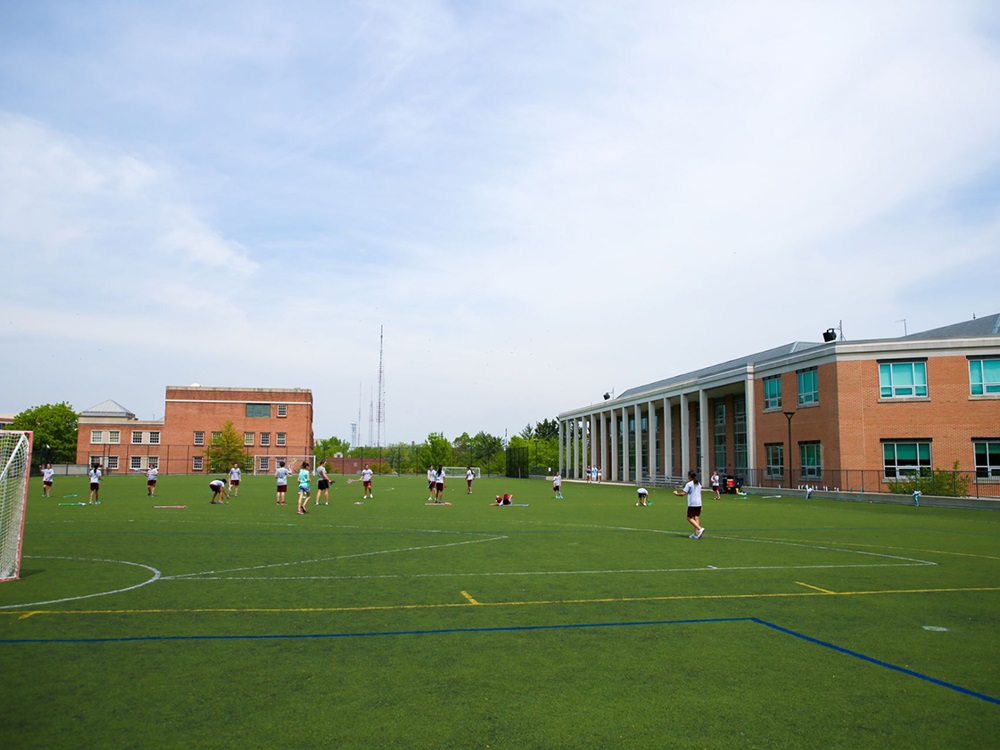
(Sidwell Friends School)
We’ll pass by Sidwell Friends School (intersection of Upton Street NW), a highly selective Quaker school, offering pre-kindergarten through secondary school classes. Founded in 1883 by Thomas Sidwell, its motto is “Eluceat omnibus lux” (English: Let the light shine out from all), alluding to the Quaker concept of inner light. All Sidwell Friends students attend Quaker meeting for worship weekly, and middle school students begin every day with five minutes of silence. The school’s admissions process is merit-based. As documented on the school’s website, it gives preference in admissions decisions to members of the Religious Society of Friends (Quakers), but otherwise does not discriminate on the basis of religion. Described as “the Harvard of Washington’s private schools,” the school has educated children of notable politicians, including those of several presidents. Both of former United States President Barack Obama’s daughters, Sasha and Malia, and former Vice President Joe Biden’s grandchildren attend the school. President Theodore Roosevelt’s son Archibald, Richard Nixon’s daughter Tricia, Bill Clinton’s daughter Chelsea Clinton, and Vice President Al Gore’s son, Albert Gore III, graduated from Sidwell Friends.
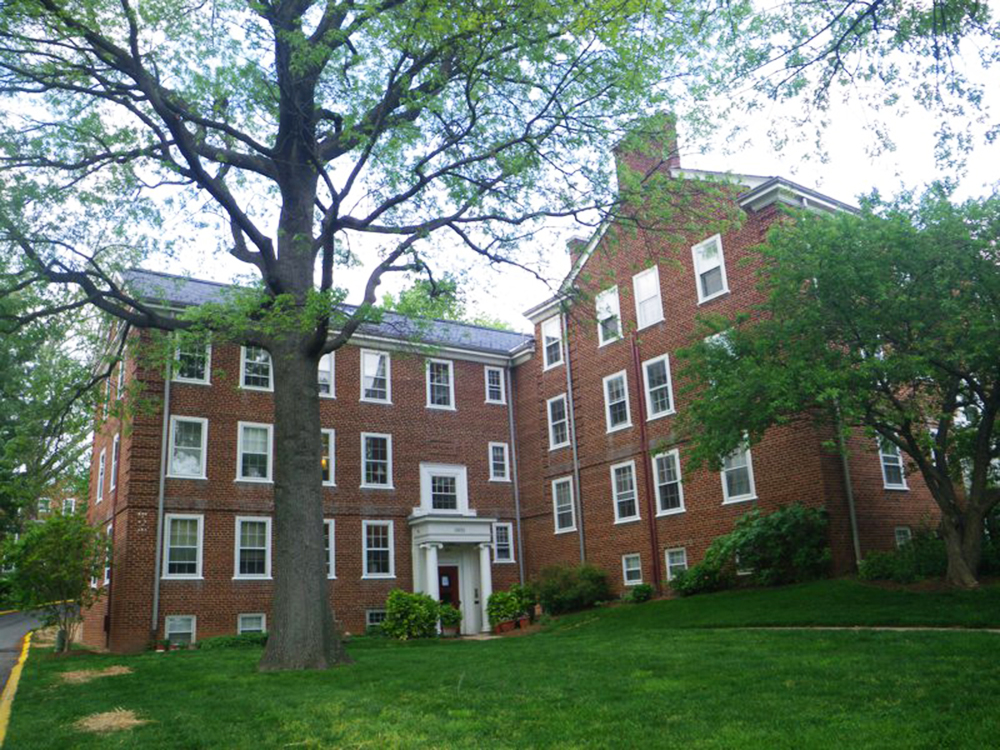
(McLean Gardens neighborhood)
Right at Sidwell Friends School, we’ll be in the McLean Gardens neighborhood, a residential neighborhood that offers residents the benefits of a park-like setting just a short walk from urban amenities such as dining, shopping and services, entertainment, Metrobus, and Metrorail. The 23-acre, wooded community has more than 1,000 residents living in 31 unique, garden apartment-style buildings built in the early 1940s and converted to condominiums in 1980 to include duplexes, flats, and lofts. Prominent residents include D.C. Council Chairman Phil Mendelson. The historically upscale neighborhood is home to many diplomats and political figures.
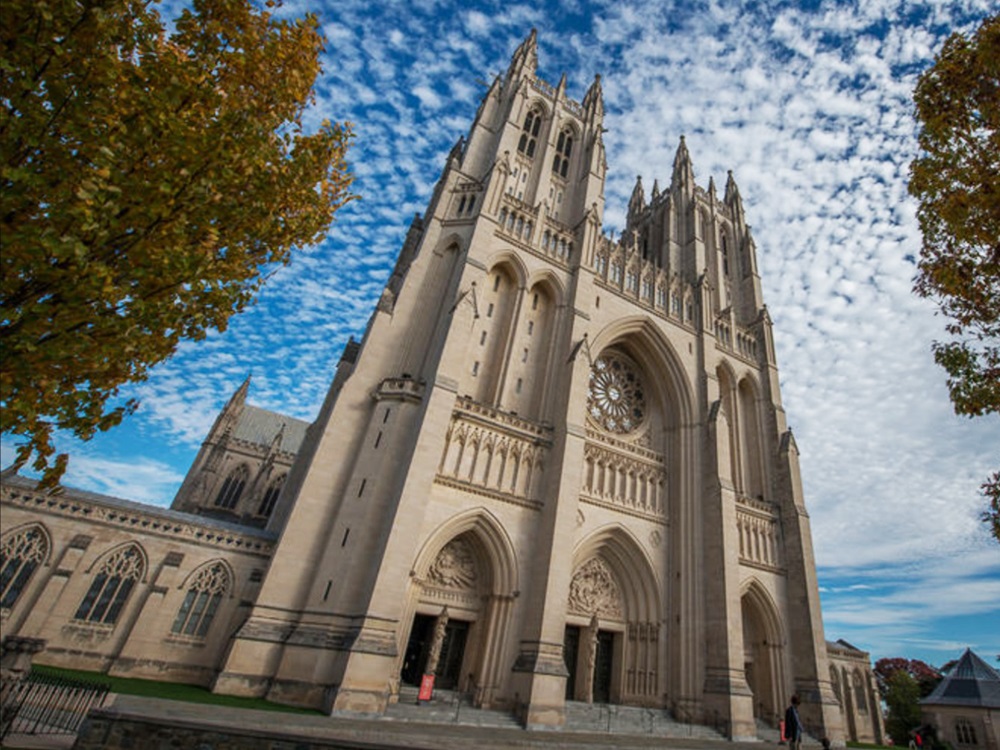
(Washington National Cathedral)
We’ll come across the Washington National Cathedral (intersection of Woodley Road NW), a cathedral of the Episcopal Church. It is both the second-largest church building in the United States, and the fourth-tallest structure in DC. In 2009, nearly 400,000 visitors toured the structure. Average attendance at Sunday services in 2009 was 1667, the highest of all domestic parishes in the Episcopal Church that year. The Protestant Episcopal Cathedral Foundation, under the first seven Bishops of Washington, erected the cathedral under a charter passed by the United States Congress on January 6, 1893. Construction began on September 29, 1907, when the foundation stone was laid in the presence of President Theodore Roosevelt and a crowd of more than 20,000, and ended 83 years later when the “final finial” was placed in the presence of President George H. W. Bush in 1990. Decorative work, such as carvings and statuary, is ongoing as of 2011. In 2007, it was ranked third on the List of America’s Favorite Architecture by the American Institute of Architects.
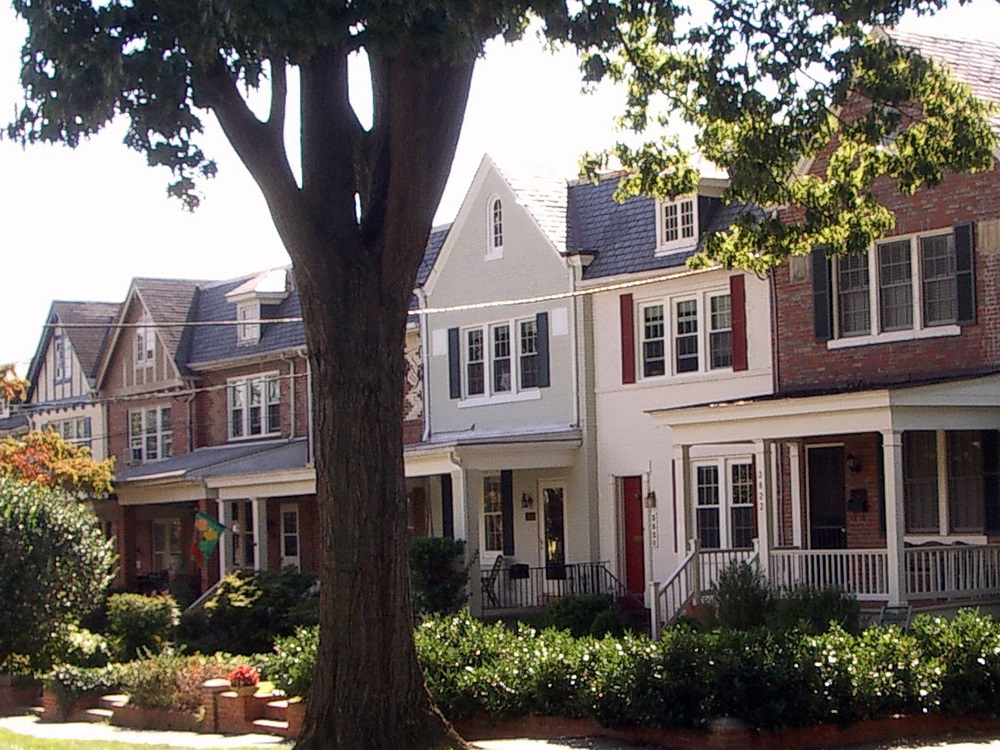
(Glover Park neighborhood)
Right at the Washington National Cathedral, we’ll be in the Glover Park neighborhood. Every morning and evening, Glover Park residents can hear the Naval Observatory play the sounding of colors synchronized to the nation’s Master Clock. The neighborhood’s elementary school, Benjamin Stoddert Elementary, is one of the most highly rated schools in the District. Neighborhood Cluster 14 (Glover Park, Cathedral Heights, and McLean Gardens) has one of the lowest crime rates in the District. The neighborhood is named for Washingtonian Charles Carroll Glover, an influential late 19th and early 20th century banker and philanthropist. He is credited with the creation of the city’s Rock Creek Park system and with an influential role in the creation of Embassy Row through generous land donations. He is also considered the father of the National Zoo and Rock Creek Parkway. The family of Charles Glover pronounces their last name so that it rhymes with “cover.” However, many people in Washington, including longtime residents, newcomers, and even the Washington Metropolitan Area Transit Authority (WMATA) pronounce the name so it rhymes with “clover.”
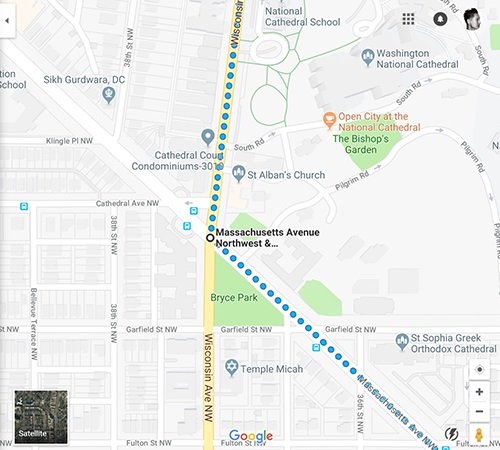
(Turn left onto Massachusetts Ave NW)
When we arrive at Massachusetts Ave NW, we’ll turn left and head southeast ~2 miles and return back to Dupont Circle.
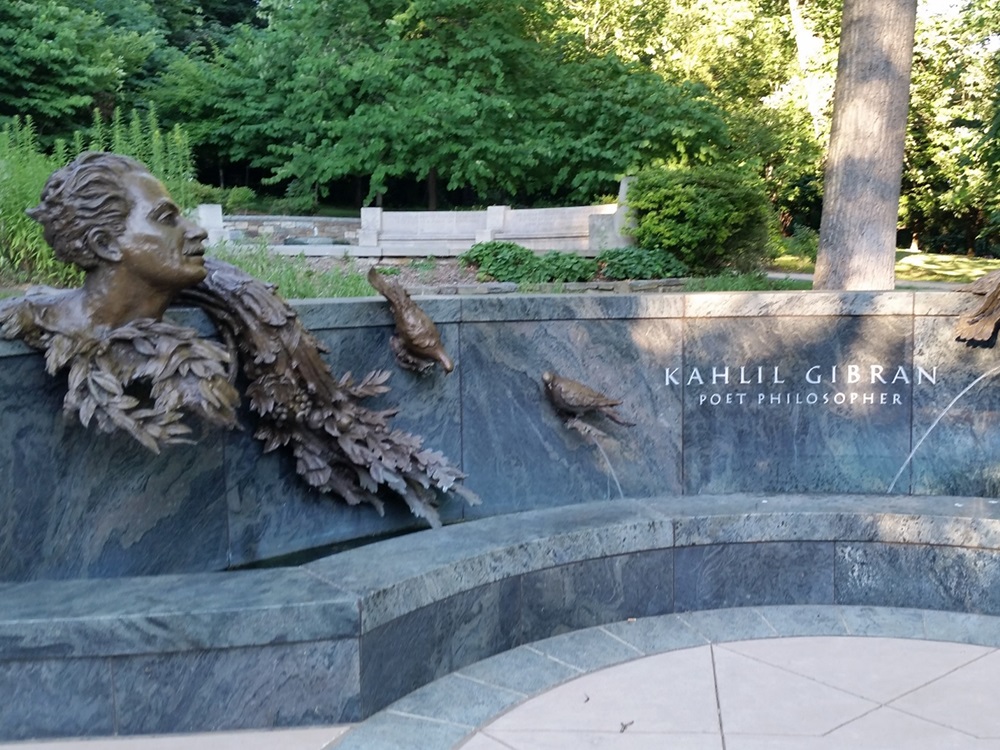
(Kahlil Gibran Memorial)
Along the way, we’ll come across the Kahlil Gibran Memorial (intersection of Observatory Circle). Located within a wooded ravine known as Woodland-Normanstone Park, the Kahlil Gibran garden memorializes the arch-deity of soupy spiritual poetry. Its centerpieces are a bust of the Lebanese mystic and a star-shaped fountain surrounded by flowers, hedges and limestone benches engraved with various Gibranisms such as ‘We live only to discover beauty. All else is a form of waiting.’ From a path just north of the garden, you can hop onto trails that link to Rock Creek and Glover Archbold parks.
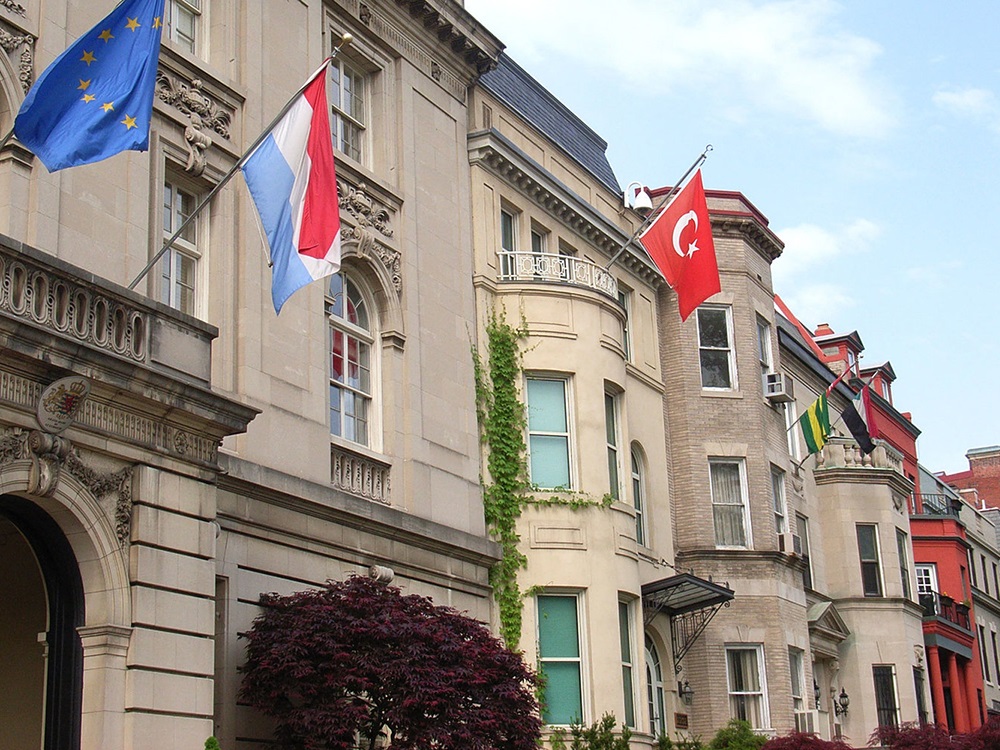
(Embassy row)
Starting from this point, we’ll enter Embassy Row (20+ embassies along the way). Embassy Row is the informal name for the section of Massachusetts Avenue between Scott Circle and the North side of the United States Naval Observatory, in which embassies, diplomatic missions, and other diplomatic representations are concentrated. By extension, the name may be used to encompass nearby streets which also host diplomatic buildings. Considered Washington’s premier residential address in the late 19th and early 20th centuries, Massachusetts Avenue became known for its numerous mansions housing the city’s social and political elites. The segment between Scott Circle and Sheridan Circle gained the nickname “Millionaires’ Row.”
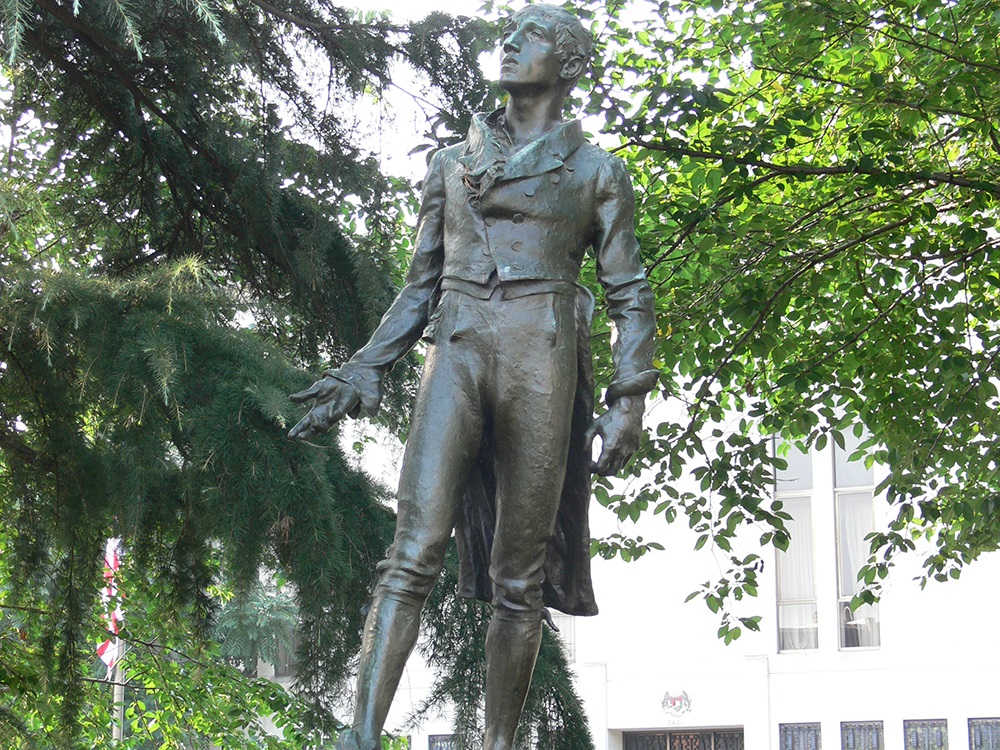
(Robert Emmet statue)
Along the way, we’ll come across the Robert Emmet statue (intersection of S Street). There are four of these statues: this one; one in St. Stephen’s Green, Dublin; Golden Gate Park, San Francisco; Emmetsburg, Iowa. Robert Emmet was an Irish nationalist and Republican, orator, and rebel leader. After leading an abortive rebellion against British rule in 1803 he was captured then tried and executed for high treason against the British king. He came from a wealthy Anglo-Irish Protestant family who sympathized with Irish Catholics and their lack of fair representation in Parliament. The Emmet family also sympathized with the rebel colonists in the American Revolution. While Emmet’s efforts to rebel against British rule failed, his actions and speech after his conviction inspired his compatriots.
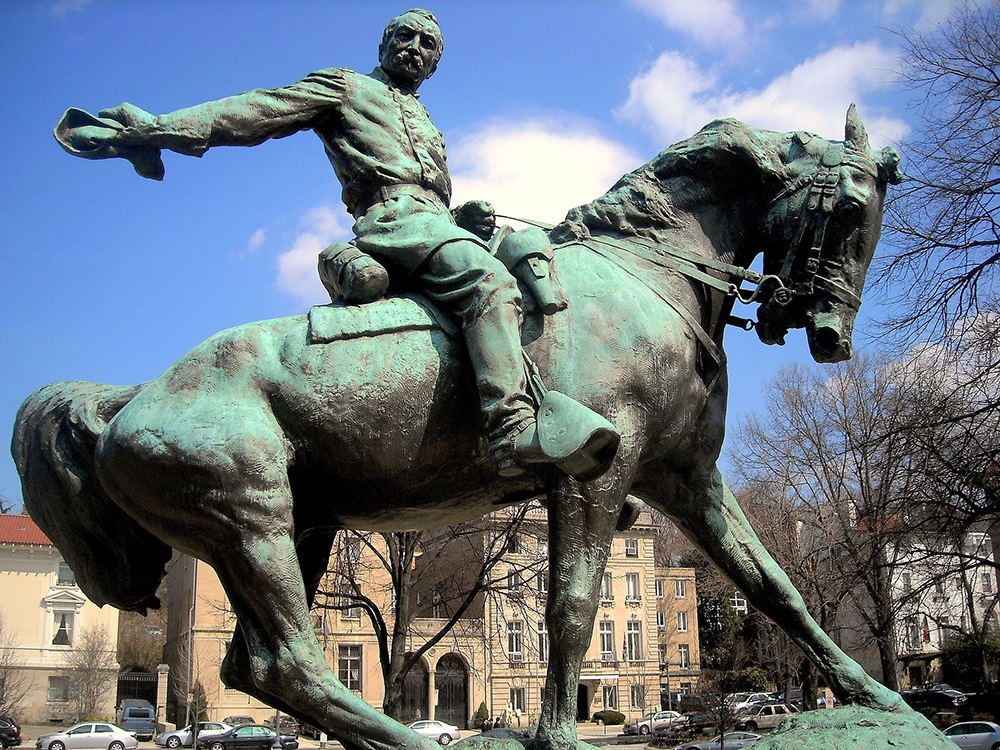
(Sheridan Circle)
Lastly, we’ll come across Sheridan Circle Park. A number of embassies ring Sheridan Circle, including the former Turkish chancery, and the Romanian embassy on the southern side, and the Embassy of Pakistan to the northwest. General Philip Sheridan is a bronze sculpture that honors Civil War general Philip Sheridan. The monument was sculpted by Gutzon Borglum, best known for his design of Mount Rushmore. Dedicated in 1908, dignitaries in attendance at the unveiling ceremony included President Theodore Roosevelt, members of the President’s cabinet, high-ranking military officers and veterans from the Civil War and Spanish–American War. The bronze statue, surrounded by a plaza and park, is one of eighteen Civil War monuments in Washington, DC, which were collectively listed on the National Register of Historic Places in 1978.
Come join us as we spend an afternoon together exploring the sites, memorials, and landmarks Connecticut and Wisconsin Ave NW have to offer! Please also help spread the word of our group and event, especially since this is relatively new technology and we are a small community!
I look forward to seeing you there!
– J.T.
—
METRO & PARKING
Closest Metro is Dupont Circle – South exit (Red line), about a 2 minute ride, and Farragut West (Orange, Blue, Silver lines), about a 5 minute ride. I suggest Metro / cabbing / Uber’ing if you can. I also recommend using wmata.com for travel planning. Don’t forget to account for Metro, traffic, and parking delays. If you are driving, you will need to find street parking or a garage. I recommend using parkopedia.com for garage parking planning.
DRESS
Please dress appropriately for the weather. For those with problems having their feet go numb or tired during long rides, I recommend wearing shoes with a stiff and flat sole.
RIDING ETIQUETTE
Since e-wheels are relatively new technology, it’s a good idea to be as courteous as possible to other pedestrians, bicyclists, etc. Being new, riding etiquette is not something that’s really been quite established. However, based on personal experience (I’ve been riding daily since 2015), I’ve noticed some general good practices. When riding on a narrow sidewalk, and you’re coming up behind a pedestrian and you need to pass them, it’s a good idea to clear your throat and say “excuse me” in a *gentle* manner (I’ve noticed people tend to get startled / surprised when they see a tall figure behind them on a wheel). Also, whenever approaching other pedestrians (whichever direction they are walking) on a sidewalk, it’s a good idea to slow down to their pace (until you are clear of them), so as to not come across as too astonishing. Same goes for when you are going around a turn (whether there are other pedestrians in sight or not) with a lot of bushes next to the sidewalk, as they can be coming from the other end of the turn (and not be visible initially).
RIDING SKILL
For the safety of others and ourselves, we will all be required to be able to perform all of the following: (1) comfortably balance on the wheel while riding straight and turning left or right (2) ride at a snail’s pace and (3) start and stop comfortably without the need to hold onto any wall, post, or similar structure.
LEGALITY
People have asked me questions regarding the laws pertaining to riding our wheels in the DC metro area. I did a lot of research before purchasing my wheel to ensure I could make use of it. In short, they are considered Personal Mobility Devices or Electric Personal Assistive Mobility Device. (1) Virginia: “An electric personal assistive mobility device or motorized skateboard or foot-scooter may be operated on any highway with a maximum speed limit of twenty-five miles per hour or less. An electric personal assistive mobility device shall only operate on any highway authorized by this section if a sidewalk is not provided along such highway…” See link here. (2) Washington DC: “Personal Mobility Device (“PMD”) means a motorized propulsion device designed to transport one person, OR a self-balancing, two non-tandem wheeled device, designed to transport only one person with an electric propulsion system. Permitted on Sidewalk – Yes, except PMDs are generally not permitted on sidewalk space in the Central Business District. Permitted on Bike Lanes – Yes.” See link here. (3) Maryland: “‘Electric personal assistive mobility device’ or ‘EPAMD’ means a pedestrian device that: (1) has two nontandem wheels; (2) is self-balancing; (3) is powered by an electric propulsion system; (4) has a maximum speed capability of 15 miles per hour; and (5) is designed to transport one person” and “At an intersection, a person using an EPAMD is subject to all traffic control signals, as provided in §§ 21-202 and 21-203 of this title. However, at any other place, a person using an EPAMD has the rights and is subject to the restrictions applicable to pedestrians under this title.” De jure, the law applies to devices with 2 wheels, as the law was written when only Segways existed and electric unicycles, et al. did not. De facto, for practical purposes, and based on our members’ interaction with law enforcement officers thusfar, our devices have been treated as being covered under this statute (they are explicitly covered under DC and Virginia law). “Green” devices for the win! See link here and here.
RAIN
If there’s a greater than a 35% chance of rain, we’ll cancel or reschedule. I’ll post an update to the top of the event posting by 11:30am on the day of the event, and also send an email out to the yes RSVPs.
< Click here to go back to RSVP page
